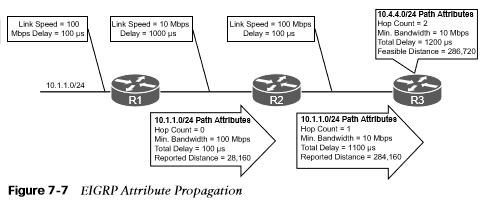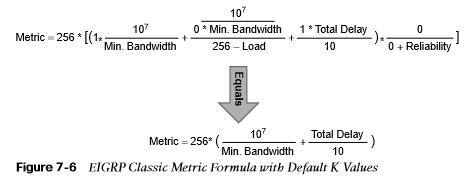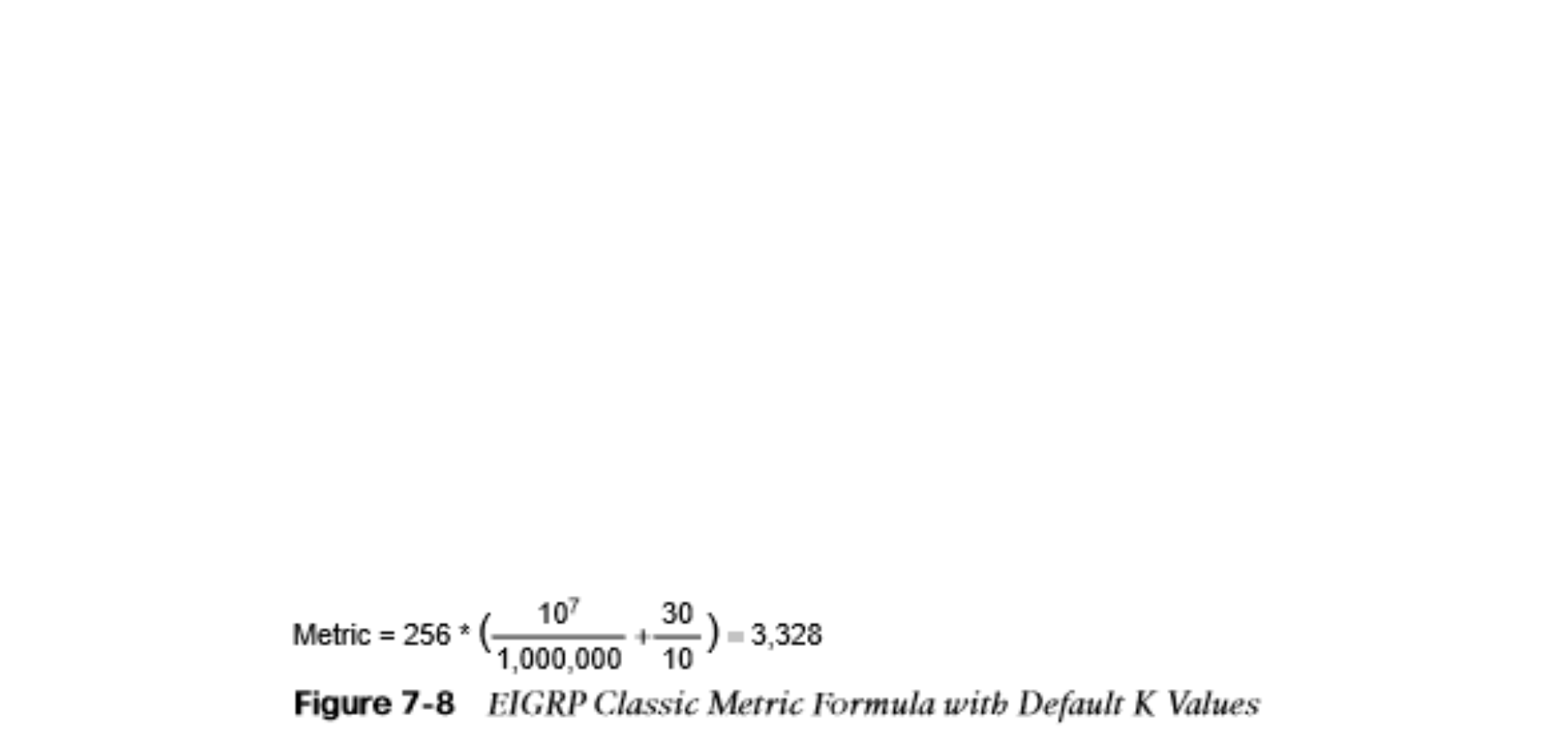
EIGRP Path Metric Calculation
how EIGRP calculates the path metric to identify the best and alternate loop-free paths.
- Metric calculation is a critical component for any routing protocol. EIGRP uses multiple factors to calculate the metric for a path.
Path Metric Calculation
EIGRP Classic Metric Formula Metric calculation uses bandwidth and delay by default, but it can include interface load and reliability, too. The formula shown in Figure 7-4 illustrates the EIGRP classic metric formula. 
EIGRP Classic Metric Formula with Definitions
- EIGRP uses K values to define which factors the formula uses and the associated impact of a factor when calculating the metric.
- BW represents the slowest link in the path scaled to a 10 Gbps link. Link speed is collected from the configured interface bandwidth on an interface.
- Delay is the total measure of delay in the path, measured in tens of microseconds (μs).
- The EIGRP formula is based on the IGRP metric formula, except the output is multiplied by 256 to change the metric from 24 bits to 32 bits.

EIGRP Classic Metric Formula with Default K Values
By default, K1 and K3 = 1, and K2, K4, and K5 = 0. 
EIGRP Attribute Propagation
- The EIGRP update packet includes path attributes associated with each prefix.
- The EIGRP path attributes can include hop count, cumulative delay, minimum bandwidth link speed, and RD.
- The attributes are updated each hop along the way, allowing each router to independently identify the shortest path.

Default EIGRP Interface Metrics for Classic Metrics

| Interface Type | Link Speed (kbps) | Delay | Metric |
| Serial | 64 | 20,000 μs | 40,512,000 |
| T1 | 1544 | 20,000 μs | 2,170,031 |
| Ethernet | 10,000 | 1000 μs | 281,600 |
| FastEthernet | 100,000 | 100 μs | 28,160 |
| GigabitEthernet | 1,000,000 | 10 μs | 2816 |
| 10 GigabitEthernet | 10,000,000 | 10 μs | 512 |
Wide Metrics
The original EIGRP specifications measured delay in 10 μs units and bandwidth in kilobytes per second, which did not scale well with higher-speed interfaces. Example 7-1 provides some metric calculations for common LAN interface speeds. Notice that there is not a differentiation between an 11 Gbps interface and a 20 Gbps interface. The composite metric stays at 256, despite having different bandwidth rates.  Example 7.1 Calculating Metrics for Common LAN Interface Speeds
Example 7.1 Calculating Metrics for Common LAN Interface Speeds
EIGRP Wide Metrics Formula
EIGRP includes support for a second set of metrics, known as wide metrics, that addresses the issue of scalability with higher-capacity interfaces. Figure 7-9 shows the explicit EIGRP wide metrics formula. Notice that an additional K value (K6) is included that adds an extended attribute to measure jitter, energy, or other future attributes. 
EIGRP Wide Metrics Formula with Definitions
EIGRP wide metrics scale by 65,535 to accommodate higher-speed links. This provides support for interface speeds up to 655 Tbps (65,535 × 10! ) without any scalability issues. 
Metric Backward Compatibility
With EIGRP wide metrics, K1 and K3 are set to a value of 1, and K2, K4, K5, and K6 are set to 0, which allows backward compatibility because the K value metrics match with classic metrics. EIGRP is able to detect when peering with a router is using classic metrics, and it unscales a metric from the formula in Figure 7-11.

Load Balancing
- Installing multiple paths into the RIB for the same prefix is called equal-cost multipathing (ECMP).
- EIGRP supports unequal-cost load balancing by changing EIGRP’s variance multiplier. The EIGRP variance value is the feasible distance (FD) for a route multiplied by the EIGRP variance multiplier. Any feasible successor’s FD with a metric below the EIGRP variance value is installed into the RIB.
- Dividing the feasible successor metric by the successor route metric provides the variance multiplier. The variance multiplier is a whole number, so any remainders should always round up.


Other useful information: